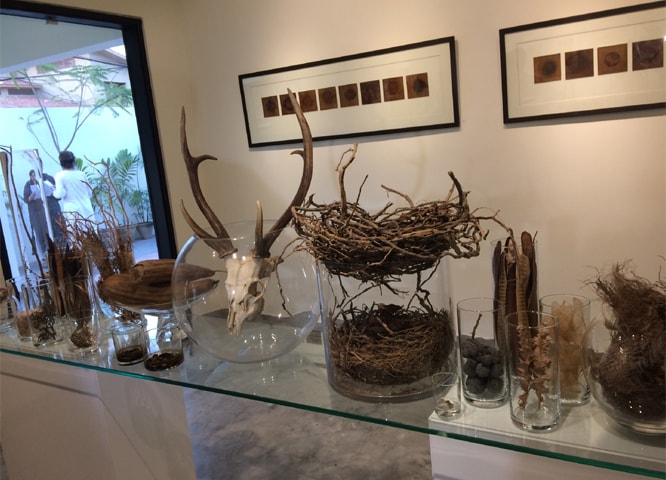
A group exhibition Botany of Desire was organised at the Koel Gallery in Karachi recently. The show, curated by Roohi S. Ahmed, included the work of 19 artists who were chosen for their practice of using botanical subjects.
Leonardo da Vinci, apart from being one of the world’s great painters and much more, was in the habit of keeping notebooks for his many drawings and detailed studies of flowers, leaves, crop plants, types of grain and a variety of berries and bramble.
Durriya Kazi’s ‘Blueprint for Love: Bonds, Knots and Roots’ reminded me of that notebook. A fascinating study, the sepia print has eight drawings of garden walls and the same number of knots displayed for stringing branches. Besides bowlines, bends, hitches and knots, the print is decorated with a border of a variety of drawn leaves.
A group show in which the artworks are inspired by botany
Leaves also feature in Amin Gulgee’s entry ‘Char Bagh — V.’ In 2009 Gulgee had a major exhibition at the Petronas Gallery in Kuala Lumpur, where an installation of 64 copper leaves was created, inspired by the four-garden plan of sixth century BC Persia and the traditional Mughal gardens of the subcontinent. The artist’s installation in copper, steel and mirror in ‘Botany of Desire’ was created this year, continuing with the theme for which he has not only made installations but also held performances based on the Char Bagh.

Abdullah M.I. Syed’s 15-panel composition ‘Currency of Love — IV’, compels the viewer into studying each of the prints of money plant leaves. There is a popular myth in South Asia that the money plant brings prosperity to homes where it is grown. Syed has plucked the damaged or dead leaves of the plant, “mending” them with Pakistani rupees, Saudi riyal or US dollar notes for this installation.
Alia Bilgrami’s miniatures, using gouache, water colour and tea wash on vasli, are titled ‘Mardi Gras’ and ‘Tulip Mermaids.’ Bilgrami has used the tulip as a recurrent symbol of displacement in her paintings. In ‘Mardi Gras’ the forewarning Urdu words ‘Ehteyaat say’ seem to be cautioning that the lone tulip be handled with care, or perhaps the layered meaning in relation to the title of the work suggests not to overdo the feasting for any kind of celebration as the human body is as fragile as a tulip.
Aliya Yousuf’s installation ‘Gharondey’ comprises of five to six all white nests of weaver birds. Cast and modeled with white kite paper and ‘layee’ they provide a purely spiritual experience — valorising nature. The ‘baya’ nest colonies are normally found on thorny trees or are built hanging near water bodies where predators cannot reach them. Despite that, the beautifully crafted nests built with twigs are exposed to dangers. Viewing ‘Gharondey,’ one was reminded of this and more.
Farah Mahbub’s photographs, ‘Zahir-o-Batin I, II, III and IV’ focus, literally, on dry twigs and branches that are either bunched up or are zigzagging. Surely when alive they were seeking their way towards light, but either they ceased to be nurtured or lost their way.

There are other appealing and stimulating works by Meher Afroz, Noorjehan Bilgrami, Sumaira Tazeen, Naima Dadabhoy, Shahana Munawar and others but cannot be described in detail due to space constraints.
A word about the curator who says in her statement, “It all began in the garden and then came expulsion!” She then makes a point about the rise of urban structures and the severing of our direct connection with nature. In putting together ‘Botany of Desire’ she may have faced certain challenges, not only related to the choice of the works but also in the spatial cognition that guides the visitor in the gallery’s space. There is also a dichotomy in the exhibition as the works on display are sombre and pulsating at the same time.
“Botany of Desire” was displayed at the Koel Gallery in Karachi from September 12 to September 22, 2017
Published in Dawn, EOS, October 1st, 2017














































Dear visitor, the comments section is undergoing an overhaul and will return soon.